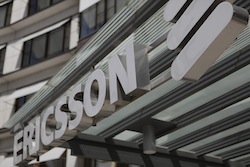Ericsson has demonstrated successful tests of Licence Assisted Access (LAA), achieving speeds of 450Mbps.
The rates were seen in Ericsson’s labs by executives from SK Telecom, Verizon and T-Mobile US. The vendor aggregated 20MHz of licensed and 40MHz unlicensed spectrum from the 5GHz band.
Ericsson, who demonstrated the technology with cooperation from chipmaker Qualcomm, said its LAA improved indoor app coverage while allowing “fair sharing” by letting Wi-Fi users access the same spectrum. It first announced it was testing the technology last month
[Read more: Ericsson turns to unlicensed spectrum to boost indoor data speeds]
LAA, also known as LTE-U, harnesses both licensed and unlicensed spectrum to enable greater capacity and higher data speeds: Licensed spectrum acts as an “anchor” for the LTE connection, while the unlicensed band provides offload space for higher throughput.
The technology is attractive to telcos looking for “pre-5G” means of improving the performance of increasingly strained mobile networks.
Neville Ray, CTO of T-Mobile, said: “With over 500MHz of under-utilised spectrum in the 5GHz Unlicensed National Information Infrastructure (UNII) band, LAA can provide our customers with superior network performance while effectively co-existing with other Wi-Fi devices to ensure a better experience for all wireless users.”
Ericsson revealed it would be incorporating LAA into its indoor small cell portfolio and Radio Dot System from the end of 2015.
It also claimed LTE-U provided an evolution from LTE-A that would prove “key” to service providers as networks evolved to facilitate the demands for technologies such as IoT.
Thomas Norén, VP and Head of Radio Product Management at Ericsson, commented: “Carrier Aggregation was an important technology trend for mobile networks in 2014 and LAA is already set to be a key focus for mobile operators in 2015.
“Innovations like LAA that improve the user experience while increasing spectrum efficiency will be significant milestones that mobile industry leaders must both drive and support.”
Read more:
Nokia, STC conduct TDD/FDD CA trial using new spectrum combinations
Spectrum rules should be relaxed to meet data demands, claims DSA



